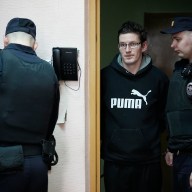YAIZU, Japan – A pair of powerful earthquakes struck at opposite ends of Asia just 12 minutes apart Tuesday, leaving one dead and more than 100 injured in Japan and sending panicked islanders in the Indian Ocean running into the streets.
The first quake, which registered magnitude 7.6 according to the U.S. Geological Survey, hit the Indian Ocean about 160 miles (257 kilometres) north of Port Blair in India’s Andaman Islands. It generated tsunami warnings in India, Myanmar, Indonesia, Thailand and Bangladesh, sparking fears of a repeat of the deadly quake-generated wave that devastated the region in 2004.
The warnings were later lifted, no tsunami was observed and there were no reports of injury or significant damage. But the quake and the tsunami warning caused fears that a deadly wave would follow, said T. Ramakrishnan, a Port Blair police official.
“People ran out of their homes in fear as they remembered the 2004 tsunami,” he said. That tsunami was triggered by a magnitude-9.0 earthquake and killed 230,000 people in a dozen countries around the Indian Ocean.
Across the Pacific in central Japan, a 6.5-magnitude quake hit just 12 minutes later, about 3,400 miles (5470 kilometres) from the first temblor.
One person was killed and several dozen injured when the quake rocked Tokyo and nearby areas shortly after dawn, halting trains and forcing two nuclear reactors to shut down for safety checks.
Police said a 43-year-old woman was killed by falling debris. At least 103 people were injured, said Yuji Hakamata, an official at the Shizuoka prefectural (state) government. Shizuoka, southwest of Tokyo, was the hardest-hit area.
Japan’s Meteorological Agency also issued a tsunami warning, but that was lifted after only small waves were observed. The quake was centred off Suruga Bay, southwest of Tokyo, at a depth of 12 miles (20 kilometres).
“The temblor was extraordinary. It was fortunate that the damage seems relatively small,” said Gen Kimura, a 61-year-old rescue volunteer, in the Shizuoka town of Yaizu. “I tried to stay calm, but the rest of my family panicked and they all went downstairs at once.”
Two reactors at the Hamaoka nuclear power plant were temporarily halted for safety checks. Reactors are automatically shut down whenever a quake of a certain strength is registered.
Koki Saguchi of Chubu Electric Power Co. said no problems or damage were initially detected at the reactors. Plant workers were to inspect the reactors fully before resuming operation.
The temblor prompted Central Japan Railway Co. to briefly stop operations of Shinkansen bullet trains, and some local trains were still out of service hours later, the company said.
A powerful quake also rattled central Japan Sunday, but caused no damage or casualties. The USGS measured that quake at magnitude 7.1.
Japan is one of the world’s most earthquake-prone countries, and experts believe Tokyo has a 90 per cent chance of being hit by a major quake over the next 50 years.
In 1995, a magnitude-7.2 quake in the western port city of Kobe killed 6,400 people.
Katsuyuki Abe, a Tokyo University seismology professor, said experts were studying whether Tuesday’s quake could foreshadow a major temblor. Tokyo was devastated by an earthquake in 1923.
“We are closely monitoring the developments and examining any changes in the region,” he said.
–
Associated Press writers Mari Yamaguchi in Tokyo, Grant Peck in Bangkok, Anthony Deutsch in Jakarta and Tim Sullivan in New Delhi contributed to this report.
















